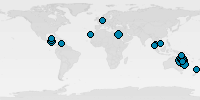We need your support and see that you installed an adblocker. Please help us by whitelisting, pausing or disabling adblock for our website greatestdivesites.com. You can also make a small donation.


149

All you want to know about the different types of Wetsuits
We need your support. Help us by disabling adblock for our website greatestdivesites.com or by making a small donation.

Every scuba diver knows you will need a 2 to 8mm wetsuit to keep you warm in milder climates (water temperatures between 10 and 24 degrees Celsius), swimming wear, aquashorts, boardshorts, dry suit and lycra suits. A wetsuit is an unmissable piece of scuba equipment that is keeping you warm by initially absorbing your body heat to warm up the first water that enters the suit and keeping it warm. We will provide you with more information about wetsuits and are going to answer questions as when do you need one and what different types exist.
When do you need one and what types exist?
As we said before; a wetsuit is most often used by scuba divers diving in waters of temperatures between 10 and 24 degrees Celsius. If the water is warmer, you probably do not need a wetsuit and can dive in thin Lycra suits (body suits) or in your shorts. In colder waters, you might be more comfortable in semi dry suits (actually thick wetsuits with better insulation and needless fits at all openings) or dry suits with a hood, boots and gloves.
Further more you will have to decide which thickness you will need and whether you prefer a full wetsuit or a semi full wetsuit that doesn't cover your under legs and arms. The thicker the suit, the warmer but you will also lose flexibility. Wetsuits are often name 4/3 wetsuit or 5/3 wetsuit. These two numbers represent the thickness of the thickest and thinnest parts of the suit. The parts that have to be more flexible are thinner than the rest.
Single and double lined neoprene wetsuits are telling you whether one side is stretched with nylon or both sides of the suit. The first suits could easily be torn so it didn't take long before they improved the wetsuits by adding a thin layer of even more stretchable nylon to it. They can do this on one side (single lined) or on both sides of the suit.
What to look for?
- Make sure the wetsuit sits tight around your body so that it cannot leak any heated water.
- Its material is very important; there are plenty of quality differences between neoprene suits so pay attention to the amount of air it can hold as it is the air that prevents heat from escaping too rapidly.
- Stitches are oke, but take a close look at the way they are stitched as they should be fully water proof and sealed.
Don't only visit dive stores to shop for wetsuits; they are also used by (wind)surfers, kayakers and rafters. Enjoy your search of the perfect wetsuit Nike Albert Heijn.


